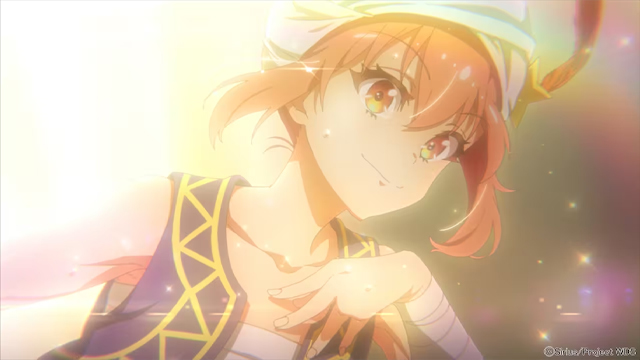The Unexpected Surprise of Starlight Revue El Dorado

Table of Contents
Lights, camera, and action! Last summer, the stage-girls from the Revue Starlight multimedia franchise made a new and brilliant appearance in the visual novel, Revue Starlight El Dorado. This completely caught everyone and me by surprise back then. Since I recently binged the original Revue Starlight anime series and movie — but had no context of the recently sunsetted Re LIVE mobile game and the supplementary material — I thought the franchise was about to just end there.
Not to mention, I was skeptical since Revue Starlight El Dorado’s game developer was Frontwing, which is more widely known for its adult visual novels like The Fruit of Grisaia. Revue Starlight El Dorado is rated 18+ with a LGBTQ+ tag on Steam — what kind of explicit romance routes would I be expecting?! Despite my surprise, I finally sat myself down to play it with a smidgen of curiosity for what was to come.

Multimedia Basics:
The Revue Starlight multimedia franchise begins with the anime series, Revue Starlight, that features nine theater girls (or “stage-girls”) from the Seisho Music Academy. These girls are the bubbly Karen Aijo, the elusive Hikari Kagari, the studious Junna Hoshimi, the motherly Mahiru Tsuyuzaki, the fickle Kauruko Hanayagi, the persistent Futaba Isurugi, the sophisticated Claudine Saijo, the insightful Maya Tendou, and the distant but insanely talented Daiba Nana. They spend an entire school year battling each other in a competition known as a “revue” to better hone their skills as stage-girls and obtain top roles in various productions like the Starlight play. There is drama, music, and overlapping themes and motifs that are directly inspired by the real Takarazuka Revue troupe in Japan. Throughout the various entries of the franchise, the characters’ chemistry continues to deepen with each other, and new rivals rise to challenge the main characters’ limits and boundaries.

Visual Novel Basics:
Revue Starlight El Dorado is a sequel to the animated movie, featuring a summer exchange program between Seisho Music Academy and Royal Academy of Theatre and Act. By the end of the program, the two schools are to collaborate and reenact the famous play, “El Dorado” (not to be confused with The Road to El Dorado Disney movie). Only eight of the nine stage-girls from the anime are fully present in the routes, with the last one’s whereabouts completely unknown until the end. The visual novel features three routes that can be played in any order and a fourth secret route that’s available after completing any of the first three.
Interestingly enough, none of the routes are actually explicit in nature — only the play’s content is minorly explicit and warrants the 18+ tag, which I do caution if you are sensitive to themes about grooming and suicide. In fact, Revue Starlight El Dorado’s routes are all completely platonic, despite the IP being known to pair up girls with romantic sub-contexts and elaborate grand themes. Each route features a pair of girls who were chosen for the leading roles in the El Dorado play with Route #1 having Karen and Junna (which echoes their first revue in the anime series), Route #2 with Kaoruko and Maya, Route #3 having Futaba and Claudine, and Route #4 with Mahiru and Nana. It’s almost like a proper revue, without the actual in-fighting. At the beginning, these matchups looked extremely promising, but to my disappointment, the story began to fall through the cracks.

Main Routes Breakdown:
Story-wise, all the routes start the same: the girls are chosen for their roles, they go through similar yet different developments to further understand their strengths and weaknesses as stage-girls, and are challenged by the exchange student Judy Knightly. Unlike most visual novels that have different storylines per route and active choice-making components that influence the ending, Revue Starlight El Dorado features none of that. All of the routes have similar plot structures, scenarios, and endings, which becomes repetitive and boring, even with alternative CGs and Easter eggs. The seiyuus do most of the heavy-lifting for the story to make it as engaging and entertaining as possible, but it doesn’t make up for the fact that the pacing remains awkward at best. It’s also unfortunately complimented with a janky UI and tiny text font that makes the game feel unpolished — I couldn’t tell you if the Steam or Switch version of the game was more pleasant to read on the eyes.
Route #1 feels the most natural with the plot structure, since Karen and Junna’s chemistry compels them to be a bit chaotic and reckless at times, which leads to shenanigans like ditching class to see the coastline and getting inspired to practice lines. I would like to think that Route #1 was written first, and the remaining routes were based off of it because Route #2 only makes small tweaks to include references to Kaoruko’s and Maya’s grievances from the anime. Route #3 is probably the most disappointing, due to the fact that Claudine and Futaba assumed senpai-kouhai roles instead of outright rivals at the beginning. Thankfully, the route is saved at the end when they decide to switch their roles in the play and properly respect each other, but their overall interactions still felt a bit forced and artificial.

Bonus Routes Breakdown:
However, Route #4 as a secret route is actually well-deserved because it showcases a complete change in structure. I adored Mahiru’s stern nagging at Nana to recognize her as a proper actress, which continues to elevate Mahiru’s character from both the anime and movie. Meanwhile, there’s so much untapped potential for Nana, who despite being the most “perfect” stage-girl and out-competing everyone in the revues, is unable to surpass the school stage and balance her two actual desires of acting and playwriting. It’s a diametric comparison in this route, and I was pleasantly surprised at how differently the entire route ended compared to the first three routes. Nana actively changing the El Dorado script to suit her as a stage-girl is a welcome change in pace, and contributes so much to the visual novel as a whole.
Overall, it is clear that the visual novel’s main routes are a hit-or-miss and cater towards the player’s biases instead. Despite my gripes with the first three routes, the secret route and the additional game mode do make up for it. Dubbed as the “El Dorado mode,” this special mode is only unlocked after clearing one of the main routes and the secret route, which allows the player to cast each of the stage-girls into different roles. It skips through all the melodrama of the girls preparing for the play and jumps right into the first act. It’s chock full of new cut-scenes, exclusive dialogue, and funny mishaps during the play. My favorite part is hearing any of the stage-girls be cast as Miguel and being subjected to a “floundering” sequence where they desperately try to swim and make blubbering noises in the water. It really breaks the seriousness of the story, and showcases the seiyuus’ talents for nonsensical noises and onomatopoeia.

With the main mechanics of the story now cleared, I’d like to focus on some of the finer points that I enjoyed greatly. These points didn’t quite elevate my playtime experience, but it definitely made me appreciate its inclusion all the same.
• Revue Starlight’s animated works usually don’t have the screen time to show the play from start to finish, so you don’t fully grasp the play’s plot nor enjoy the characters’ singing parts. Meanwhile, the El Dorado play is completely fleshed out with two proper acts, an intermission, and lots of singing and monologues from the girls for the audience to properly immerse themselves. For fans who love musicals or general performances, Revue Starlight El Dorado fits all of this perfectly in a low-stakes and short game.
• The “antagonist” Judy Knightly is an absolute gem in the visual novel, and is perhaps my favorite character in El Dorado. She is seemingly flawless like Nana or Maya, but has a hidden geeky side that isn’t cringey, making me fall for her all the same. To my pleasant surprise, Judy is voiced by the retired Takarazuka Revue otokoyaku veteran Hiryuu Tsukasa, which is all too fitting for the franchise with her strong masculine voice and energy.
• Finally, the LGTBQ+ tag isn’t for show. Despite the main routes having platonic pairings as rivals, there are still hidden mentions of girls who are exceptionally close to each other, and a particular couple that quite literally becomes canon by the end of the visual novel. I was rooting for them all throughout the novel and was so pleased with how it turned out that I smashed my screenshot button thrice on my Switch.

Final Thoughts:
Evidently, my feelings about Revue Starlight El Dorado are rather mixed, though leaning more positive than naught. On one hand, I was fairly disappointed by the unpolished feel of the game, the storyline, and some of the character dynamics in the routes. It felt like a missed opportunity, considering that Bushiroad could’ve taken their time to develop it and extend the franchise even more, or use the medium as an alternative entry point to the franchise.
On the other hand, I was thrilled to covet this small, but niched visual novel that nearly catered to me, such as casting an actual Takarazuka Revue veteran voice in a Takarazuka Revue-inspired series, having a play unfold in the form of a video game, or just seeing two cute girls essentially get married on screen. I don’t see myself replaying Revue Starlight El Dorado in the near future, but I can at least savor that bittersweet summer of the stage-girls acting out a major play and the sunsetting of the Re LIVE mobile game.
If you liked the article, do not forget to share it with your friends. Follow us on Google News too, click on the star and choose us from your favorites.
If you want to read more anime-manga articles, you can visit our anime-manga category.




